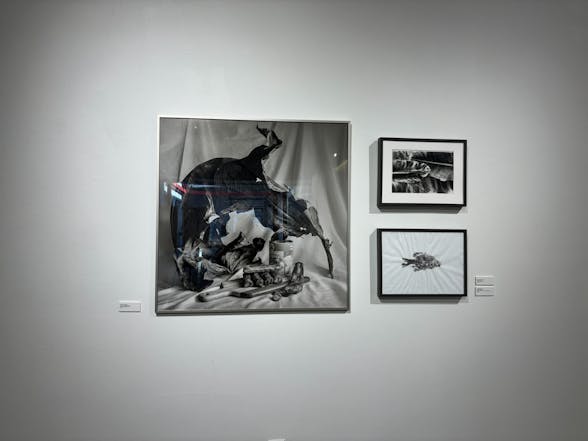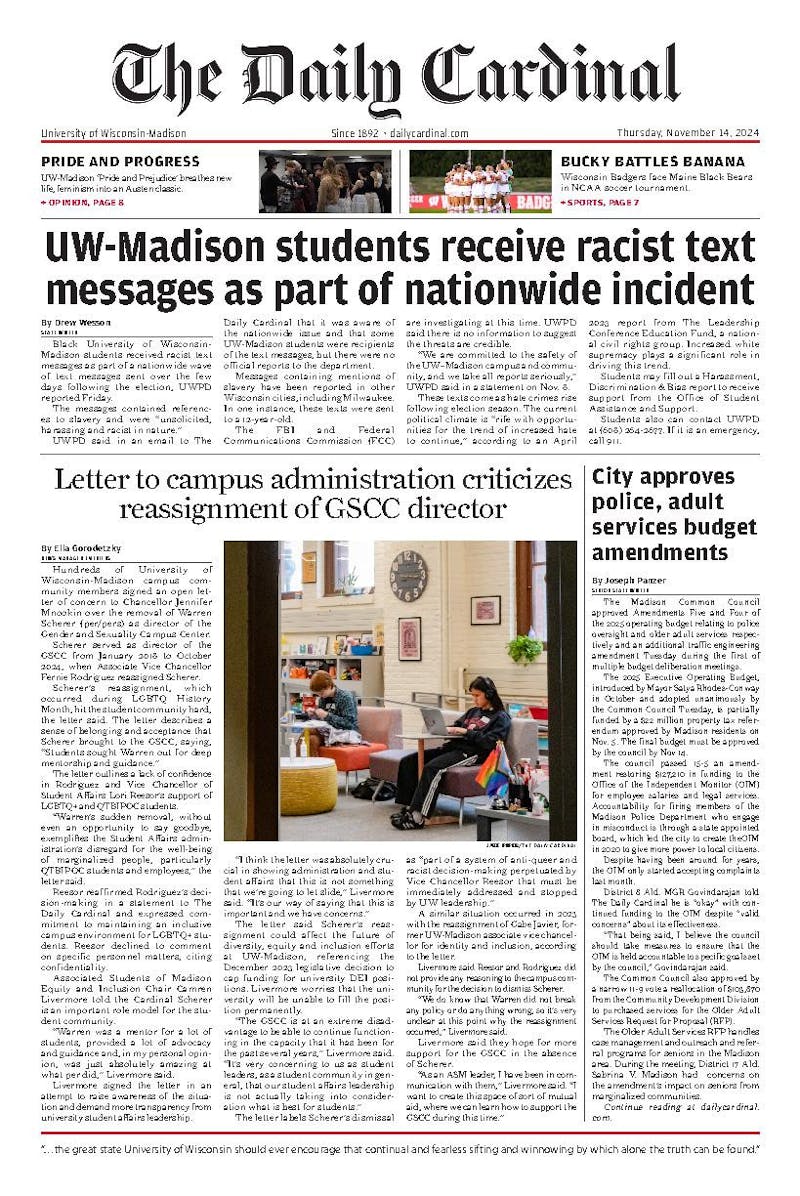University of Wisconsin-Madison graduate photography students showed off their work at the “Take My Word For It” photography exhibition, which concluded Sunday at the Arts Lofts Gallery.
The exhibition gave gallery-goers an up-close look at the artists’ and their personal stories.
Second year grad student Mariah Moneda displayed three pieces, all of which centered around her Filipino culture and connection with food. Her selected pieces, “Banana Leaves,” “Black Crappie” and “Turon and Banana Leaf,” gave her audience a glimpse into Filipino food traditions important to her.

Mariah Moneda's work on display at the graduate photography exhibition "Take My Word For It."
“Most of my work revolves around this idea of labor and community, and the way that we showed love in my family actually had a lot to do with the gestures of feeding each other,” Moneda told The Daily Cardinal. “Even when we were mad at each other or we were fighting, there was this idea that you still deserve a seat at the table. You still deserve sustenance. You deserve to live.”
Through her work, Moneda visually explored her personal connection to food, the sustenance it provides and the decay that stems from wasted scraps.
In “Turon and Banana Leaf,” Moneda photographed a staged still life of turon, a Filipino dessert, and a decaying banana leaf to spark conversation on where your meals come from and where they’re discarded.
“You can't have a meal without all the discard that comes with it, and I think that's really indicative of how you can't have all the good things without having all the bad things,” Moneda said. “I really love this visual motif of life and death and the juxtaposition between the two.”
Before starting graduate school at UW-Madison, much of Moneda’s work centered around domestic life and her family. When she moved away from her family in Arizona to Wisconsin, she struggled to figure out how to continue incorporating her culture and family traditions into photography.
Moneda recalled the first time she stumbled across something that reminded her of home and how that experience inspired some of her more recent photography work.
“I had this really surreal moment where I was in a Thai restaurant, and I had this very simple rice soup that was so reminiscent of one that I've had from my childhood,” she said. “I remember smelling it and then just bursting into tears in the middle of this Thai restaurant because I’m so far away from home and everything I know.”
Moneda said that moment sparked a realization: food is a connection to her roots as well as a way to “move forward and build a new community.”
“Food is this invitation to bring people to a place they usually wouldn’t go,” Moneda said. “I talk a lot about how food is a tool I use to invite others into my space.”
While Moneda said cooking helped her build a community in Wisconsin, she still grieves being away from her community back home.
“For me, I think it's also this gesture of grief and a send off because so much of what I'm able to share with my new community comes from my old community that I don't have anymore, which is why I'm attempting to build a new one in the first place,” Moneda said.
While Moneda’s work in the exhibition focused on her Filipino culture and relationship with food, second year graduate student Mark Almanza explored personal struggles that come with being a first-generation Mexican-American.
“I've never felt Mexican enough or American enough, and so I’m living in this kind of middle space of identity,” Almaza told the Cardinal.
In one of Almanza’s self portraits titled “El Perron y El Perrito,” Almaza captured himself sitting center-frame in a wooden chair holding a little stuffed dog. In the portrait, he donned a cowboy hat and a western belt buckle.
Another self-portrait titled “El Águila Sobre un Nopal,” meaning “The Eagle on a Cactus,” features Almaza sitting shirtless in front of a tapestry of an eagle. The eagle tapestry serves as a symbolic representation of his Mexican heritage, calling on the nation’s flag which encapsulates an image of an eagle.
Almaza said his photography allows him to take on issues with machismo, which he said is a strong sense of masculine pride embedded in Latino culture, and explore what it means to exist in a space between two cultures.
“Self-portraiture really allows me to choose a lane and be the person that I might want to be,” Almaza said.
Beyond Moneda and Almaza’s work, the exhibition as a whole served as a collection of deeply personal experiences and stories told visually through photography, living up to the exhibition’s name, “Take My Word For It.”
Anna Kleiber is the state news editor for The Daily Cardinal. She previously served as the arts editor. Anna has written in-depth on elections, legislative maps and campus news. She has interned with WisPolitics and Madison Magazine. Follow her on Twitter at @annakleiber03.






